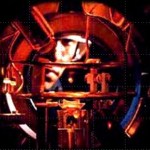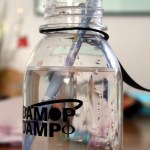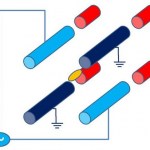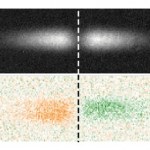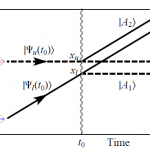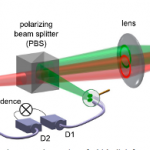Lasers
Today's dip into the cold-atom toolbox is to explain the real workhorse of cold-atom physics, the magneto-optical trap. This is the technology that really makes laser cooling useful, by letting you collect massive numbers of atoms at very low temperatures and moderate density.
Wait a minute, I thought we already had that, with optical molasses? Doesn't that make atoms really cold and stick them in space? Molasses does half the job, making the atoms really cold, but it doesn't actually confine them. The photon scattering that gives you the cooling force and Doppler cooling limit produces a "…
This topic is an addition to the original list in the introductory post for the series, because I had thought I could deal with it in one of the other entries. Really, though, it deserves its own installment because of its important role in the history of laser cooling. Laser cooling would not be as important as it is now were it not for the fact that cooling below the "Doppler limit" in optical molasses is not only possible, but easy to arrange. That's thanks to the "Sisyphus cooling" mechanism, the explanation of which was the main reason Claude Cohen-Tannoudji got his share of the 1997…
Last time in our trip through the cold-atom toolbox, we talked about light shifts, where the interaction with a laser changes the internal energy states of an atom in a way that can produce forces on those atoms. This allows the creation of "dipole traps" where cold atoms are held in the focus of a laser beam, but that's only the simplest thing you can use light shifts for. One of the essential tools of modern atomic physics is the "optical lattice," which uses patterns of light to make patterns of atoms.
OK, what do you mean "patterns of light"? Well, remember, light has both wave and…
The last post in this series on the core technologies of cold-atom physics dealt with optical molasses, where you use the scattering of light to exert forces on atoms to make them very, very cold. It turns out, they end up even colder than the simple theory would lead you to expect, which is very surprising, but also essential to the revolutionary impact of cold atom physics. If you were stuck with the Doppler cooling limit temperatures, laser cooling probably wouldn't be as big a deal as it is now.
You can do better, though, thanks to the interaction of several bits of physics that go beyond…
`Once upon a time there were three little sisters,' the Dormouse began in a great hurry; `and their names were Elsie, Lacie, and Tillie; and they lived at the bottom of a well--'
`What did they live on?' said Alice, who always took a great interest in questions of eating and drinking.
`They lived on treacle,' said the Dormouse, after thinking a minute or two.
`They couldn't have done that, you know,' Alice gently remarked; `they'd have been ill.'
`So they were,' said the Dormouse; `VERY ill.'
-- Lewis Carroll, Alice's Adventures in Wonderland, Chapter 7
As an undergrad, I did my senior…
This series of posts is intended to explain the tools and tricks used to create and manipulate samples of ultra-cold atoms; thus, it's appropriate to start with how we get those atoms in the first place. This will be a very quick background on the basic force used to make atoms cold, and then the technology of atom sources for a variety of experiments.
Okay, so you've got two things in the post title. Which are we going to talk about first? Well, the study of cold atoms really begins with the observation that light can be used to push atoms around. There are actually two ways to do that, but…
The other day, I made a suggestion to one of my research students of an experiment to try. When I checked back a day later, she told me it hadn't worked, and I immediately realized that what I had told her to do was very stupid. As penance, then, I'll explain the underlying physics, which coincidentally has a nice summer-y sort of application alluded to in the post title.
If you're the sort of person who enjoys swimming, and can either open your eyes underwater or regularly wear a mask or goggles, you've probably notice that the underside of the surface of a swimming pool or other body of…
Hey, dude? Yeah, what's up?
I'm not normally the one who initiates this, but I was wondering: When you were at DAMOP last week, did you see any really neat physics? Oh, sure, tons of stuff. It was a little thinner than some past meetings-- a lot of the Usual Suspects didn't make the trip-- but there were some really good reports from a lot of groups.
Anything really surprising? Well, there was one talk that I really liked a lot, that I went to on a lark, because I didn't understand what the session title could possibly mean, and there was no abstract for the talk: Experimental Studies of…
In which I unpack a cryptic paper title and explain how quantum superposition lets you use light to keep things from interacting with light.
-------------
I joined AAAS a couple of years ago to get a break on the registration fee for their meeting, and I've kept up the membership mostly because I like having individual access to Science articles, so I can read them in the coffee shops where I get actual work done. This also gives me access to articles in the "advance online publication" stage, which is hilarious because Union's institutional subscription doesn't include those articles-- if I'…
OK, it's a paper I mentioned here before, when it went up on the arxiv, but the "Comments on Atomic, Molecular, and Optical Physics" article I wrote this summer is up on the Physica Scripta web site now, and for the next not-quite-thirty days it's free to read and download:
Searching for new physics through atomic, molecular and optical precision measurements
We briefly review recent experiments in atomic, molecular and optical physics using precision measurements to search for physics beyond the Standard Model. We consider three main categories of experiments: searches for changes in…
Continued slow liveblog of the New Frontiers in Astronomy and Cosmology Conference at the Franklin Institute.
Lunch is almost over and we are headed into the final session of research presentations, clearly saving the best for last...
I am also reminded why we have these meetings, in person, the chats during break and back and forth in sessions provides very dense information transmission and tight feedback loops on news.
Big Question IV - Are we Alone in the universe?
Or, are there other life and intelligence beyond the solar system?
1) Jonathan Lunine from Cornell on "The search for life…
In which we do a little imaginary Q&A to explain the significance of Tuesday's Nobel Prize to Dave Wineland and Serge Haroche.
------------
I did a quick post Tuesday morning noting that the latest Nobel Prize in Physics was awarded to two big names from my corner of the field. This would've been a great time to drop a long explainer post about what they did and why it's cool, but alas, I have a day job, and the Nobel committee stubbornly refuses to tell me who they're giving the prizes to in advance. Oh, well.
Still, I'm just vain enough to think I can add something a little different…
In which we do a little ResearchBlogging to look at a new paper about weird quantum effects, entangling two photons that never both exist at the same time.
------------
I'm teaching full-time this term, but I've blocked out Thursdays as a day when I don't do class- or chair-related work. Usually, this means trying to write something on the work-in-progress, but I finished a short thing in the morning that needed to sit for a few hours before I looked at it again, which left a nice opportunity for some blogging. And, conveniently, somebody retweeted a New Scientist story about an arXiv…
So, it's been a while, but let's see if we can't hit the ground running with a good physics post. There have been a few notable physics events since I went on hiatus, but for a return to physics ResearchBlogging, we'll go with something near and dear to my heart, ultracold atoms. Specifically, this Science paper (free arxiv version) about passing atoms through a narrow channel. This is a cool bit of subfield-crossing physics, so let's dust off the Q&A format, and go through it.
Hey, dude, long time no see. So, what's the deal with this paper? Well, the title pretty much tells you what's…
In which we look at a slightly crazy-sounding proposal from my former boss, the experimental realization of which is getting close to completion.
------------
I spent more or less the entire first day of DAMOP a couple of weeks ago going to precision measurement talks. Most of these were relatively sedate (at least by the standards of a sub-field that routinely involves people proposing incredibly difficult experiments), but my boss when I was at Yale, Mark Kasevich, provided the bold proposals I usually expect, in this case suggesting an experiment using an atom interferometer to measure…
In which we do a little ResearchBlogging, taking a look at a slightly confusing paper putting a new twist on the double-slit experiment.
------------
I'm off to California this afternoon, spending the rest of the week at DAMOP in Pasadena (not presenting this year, just hanging out to see the coolest new stuff in Atomic, Molecular, and Optical Physics). I don't want to leave the blog with just a cute-kid video for the whole week, though, so here's some had-core physics: a new paper in the Proceedings of the National Academy of Sciences (freely available online), looking at a new sort of…
I've been busily working on something new, but I'm beginning to think I've been letting the perfect be the enemy of the good-enough-for-this-stage, so I'm setting it aside for a bit, and trying to get caught up with some of the huge number of things that have been slipping. Which includes getting the oil changed in my car, hence, I'm sitting in B&N killing time, which is a good excuse to do some ResearchBlogging.
Last week was a banner week for my corner of physics, with three really cool experiments published. Two of those are on the arxiv, which means I can use images from the paper (…
Yesterday's equation was the first real result of quantum theory, Max Planck's formula for the black-body spectrum. Planck never really liked the quantum basis of it, though, and preferred to think of it as just a calculational trick. It wasn't until 1905 that anybody took the idea really seriously, leading to today's equation:
From the year, you can probably guess the guy responsible: Albert Einstein. Einstein realized that if you took Planck's idea and ran with it, you could explain the photoelectric effect very neatly. Where Planck had viewed the quantized radiation as a fictitious…
A physics story makes the front page of the New York Times today. Sadly, it's with the headline Laser Advances in Nuclear Fuel Stir Terror Fear. Sigh.
The key technological development, here, is that General Electric has been playing around with a laser-based isotope separation technique. This is an idea that's been around for a long time, with lots of different people working on it. GE's technology is based on an idea from some Australians back in the 1990's, and they appear to think they can scale it up to industrial scale. Predictably enough, there's a stark difference of opinion about the…
The second in the DAMOP research categories I talked about is "Extreme Lasers," a name I was somewhat hesitant to use, as every time I see "Extreme [noun]," I get a flash of Stephen Colbert doing air guitar. It is, however, the appropriate term, because these laser systems push the limits of what's possible both in terms of the pulse duration (attosecond pulses are common, with 1as = 0.000000000000000001 s) and the pulse intensity (1014 W/cm2 is a typical order-of-magnitude, and some systems get much higher than that).
One of the main tricks for generating these ultra-short pulses is to do…
